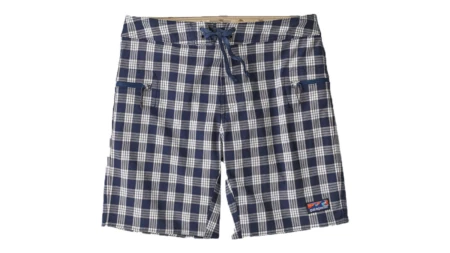Gerry Lopez Shares the History Behind our Cotton Boardshorts
Our board shorts line has a new addition with a long history. The Patagonia Organic Cotton Canvas Boardshorts, or Palaka shorts as they were originally known, come with a special heritage in not only the surf world but old Hawaii as well.
When I started surfing in the late 1950s, Palaka shorts were one of the earliest fashion statements of an emerging surf culture. Surf shorts were a hard thing to come by back then, none were available commercially. Surfers in the know would go to specialty Japanese tailor shops like Take’s in Waikiki or H. Miura’s in Haleiwa to order a pair of custom fitted shorts. More often than not, the material of choice would be Palaka cotton. One of the reasons for choosing this print was because many of the best surfers in Hawaii already were wearing it. But also because it was a sturdy fabric that was comfortable after several washings and would last through many years of hard use. It must be remembered that surfers of that period wore their shorts all day, every day, every month throughout the year. These shorts, quite literally, were lived in.
The history behind the fabric is a story in itself. Hawaii began to develop as a powerful plantation economy based on sugar, pineapple and coffee in the late 1800s. The workers needed a rugged shirt for their hard labor especially in the sugar cane fields. The pattern came from the field laborers customizing their shirts for practical use and protection from the hot sun by cutting off the tails to give it a straight hem to be worn outside the trousers.
Around the 1920s the blue and white checkered denim Palaka became the standard material of these shirts. The name Palaka is a transliteration into Hawaiian of the English word frock for the loose-fitting shirt worn by British and American sailors to Hawaii. While the Hawaiians were asking about the fabric, they were given the name of the style of shirt instead. Soon Palaka came to mean the dark blue and white woven fabric the shirts were made of. Eventually this Palaka shirt and blue denim trousers called sailor-mokus became a traditional Hawaiian costume both on and off the plantations.
The aloha or Hawaiian print shirt came directly from this standard Plantation Palaka shirt design. Sometimes the Palaka fabric was reversed to show the muted side and this also became a tradition still much used today in the aloha shirt industry.
The history of Palaka in both the surf garment and aloha shirt industries is a rich one indeed and, if one will pardon the pun, comes with a very checkered past.
Live with Aloha.
For more stories from Gerry, check out his book Surf Is Where You Find It.

